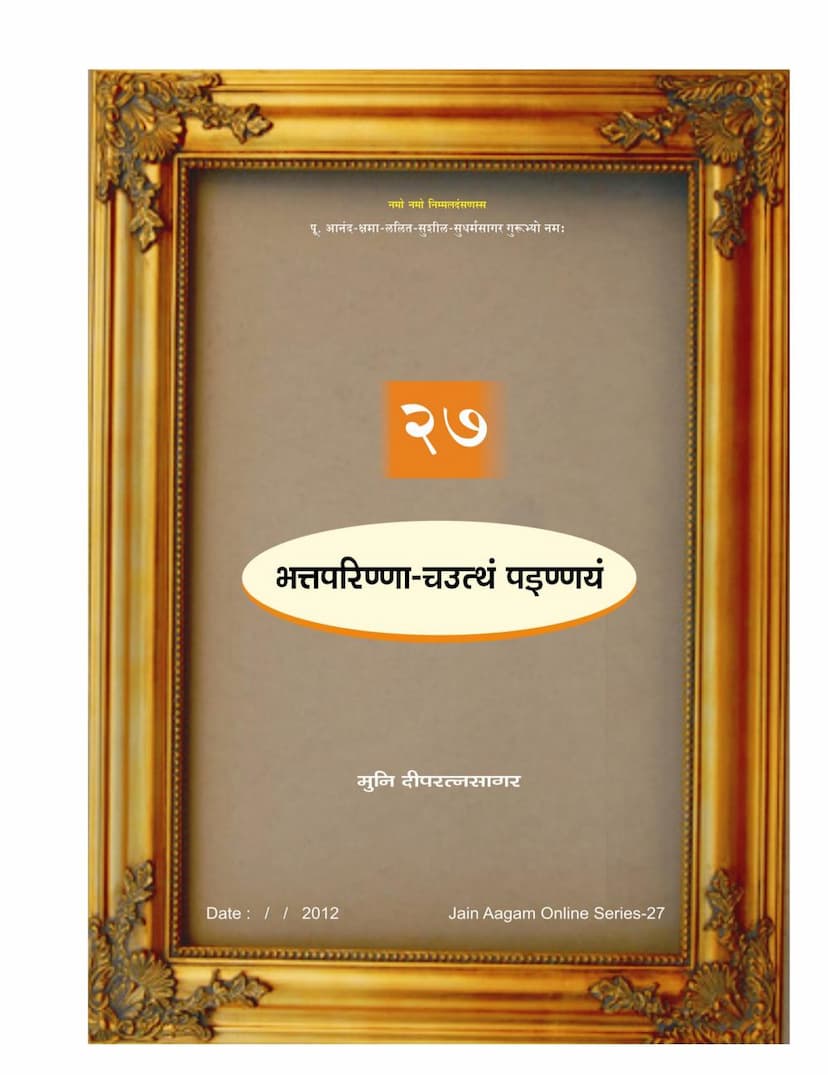Agam 27 Bhattaparinna Chauttham Painnayam Mulam PDF File
Added to library: September 1, 2025

Summary
This document is a Jain religious text titled "Agam 27 Bhattaparinna Chauttham Painnayam Mulam," authored by Dipratnasagar and published by Deepratnasagar. It's part of the Jain Aagam Online Series. The text is a commentary or elaboration on the concept of Bhattaparinna, which refers to a specific type of death in Jainism, often associated with renunciation and spiritual attainment.
Here's a breakdown of the content based on the provided pages:
Overall Structure and Purpose:
- The book is dedicated to the Jain tradition and venerates Mahavira, the 24th Tirthankara.
- It emphasizes the rarity and value of the Jin Shasan (Jain doctrine) and the importance of attaining eternal happiness through right faith, knowledge, and conduct.
- The text aims to guide individuals towards a path of spiritual progress, particularly focusing on the end of life and the attainment of liberation (moksha).
Key Themes and Concepts:
-
Importance of Right Knowledge and Conduct (Gāthā 7-8): The text stresses the significance of adhering to the teachings of the Tirthankaras, which include right knowledge (jnana), right faith (darsana), right conduct (charitra), and penance (tapa).
-
Different Paths to Liberation (Gāthā 9-12): It discusses various methods of ending one's life with spiritual intent, specifically mentioning:
- Bhattaparinna: A form of death, possibly voluntary fasting or renunciation.
- Ingini: Another term for a specific practice.
- Paovavagamm: A practice of attaining a state of mind.
- It further categorizes Bhattaparinna into saviyaram (with intention/thought) and aviyaram (without intention/thought).
-
The Nature of Suffering and Liberation (Gāthā 13-17): The text highlights the suffering inherent in the cycle of birth and death (samsara), emphasizing the impermanence of worldly pleasures and the dangers of the cycle of rebirth. It encourages detachment from worldly desires and seeking true, eternal happiness.
-
The Process of Renunciation and Acceptance (Gāthā 18-23): A disciple approaching a Guru to seek permission for renunciation is described. The Guru guides the disciple through the necessary steps, including confession (alochana), seeking forgiveness (kshamana), and undertaking penance (pratikraman and tapa).
-
Observance of Vows and Principles (Gāthā 24-33): The text details the acceptance and observance of great vows (mahavratas) and smaller vows (anuvratas). It discusses the importance of maintaining a pure mind, devotion, and adherence to the principles of Jainism.
-
Dietary Restrictions and Spiritual Practices (Gāthā 34-46): A significant portion focuses on the practice of abstaining from food (pachchakkhana). It describes the process of gradual renunciation of different types of food, including solid food and water, as a means to purify the body and mind. The role of the community (sangha) and the Guru in this process is highlighted.
-
Confession and Forgiveness (Gāthā 47-50): The importance of seeking forgiveness from the entire community (Guru, fellow monks, laypeople) for any faults or transgressions is emphasized. This act of confession is seen as a way to purify oneself and shed accumulated karma.
-
The Core Teachings of Jainism (Gāthā 53-100): A substantial part of the text delves into fundamental Jain principles:
- Right Faith (Sammyaktva) (Gāthā 53-69): The paramount importance of samyaktva (right faith) is repeatedly stressed. It is considered the foundation for right knowledge, conduct, and penance. Without right faith, liberation is impossible.
- Devotion to Tirthankaras and the Jain Sangha (Gāthā 70-77): Deep devotion (bhakti) to the Tirthankaras, Siddhas, idols, the Jain order, gurus, and all virtuous beings is considered essential for spiritual progress and attaining liberation.
- The Power of Namo-kar Mantra (Gāthā 76-81): The five-lettered mantra (Panch Namaskar) is highlighted as a powerful tool for spiritual growth and attaining auspiciousness, even for those who are simple or unlearned.
- Controlling the Senses and Desires (Gāthā 82-117): The text strongly advises against attachment to sensory pleasures, particularly those related to women and sensual desires. It describes the dangers and suffering caused by such attachments and the importance of controlling the mind and senses.
- Non-violence (Ahimsa) (Gāthā 89-96): The principle of ahimsa is deeply explored, emphasizing the interconnectedness of all living beings and the idea that harming others is harming oneself. It also points out that the results of ahimsa are positive worldly outcomes like health and prosperity.
- Truthfulness (Satya) (Gāthā 97-100): The importance of speaking the truth, the consequences of lying, and the respect accorded to truthful individuals are discussed.
-
Renunciation of Worldly Possessions and Attachments (Gāthā 131-134): The text encourages detachment from all forms of possessions, attachments, and worldly involvements, stating that true liberation is found in complete renunciation.
-
Overcoming Desires and Passions (Gāthā 135-151): The text discusses the obstacles to liberation, such as desires (rāga), aversions (dveṣa), and delusion (moha), which are further classified into various types. It advises the practitioner to overcome these passions through self-control and adherence to the teachings.
-
Examples of Spiritual Attainment (Gāthā 160-163): The text provides examples of individuals who achieved spiritual perfection through practices like fasting and enduring intense suffering with equanimity, demonstrating the power of their vows and faith.
-
The Ultimate Goal (Gāthā 166-173): The text concludes by emphasizing the auspiciousness of following the true Dharma, the teachings of Jainism, and its power to prevent suffering in this life and the next. It describes the practice of Bhattaparinna as a means to attain ultimate bliss and liberation.
In essence, "Agam 27 Bhattaparinna Chauttham Painnayam Mulam" is a comprehensive guide to spiritual discipline within Jainism, focusing on the principles of detachment, non-violence, truthfulness, self-control, and devotion as pathways to overcome the cycle of suffering and achieve eternal liberation. The text underscores the critical role of the Guru and the Sangha in this journey, and the ultimate significance of death with spiritual awareness and detachment.